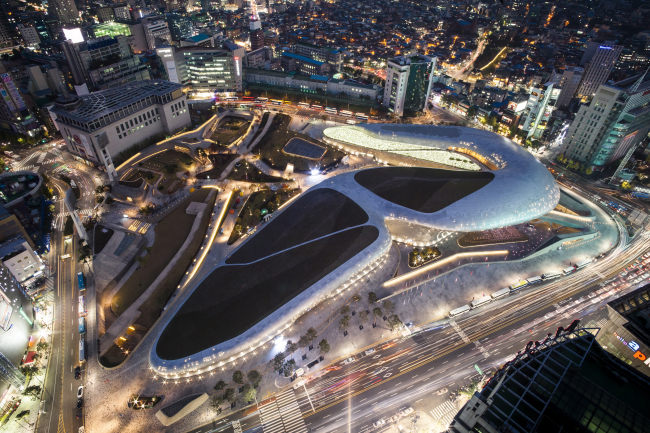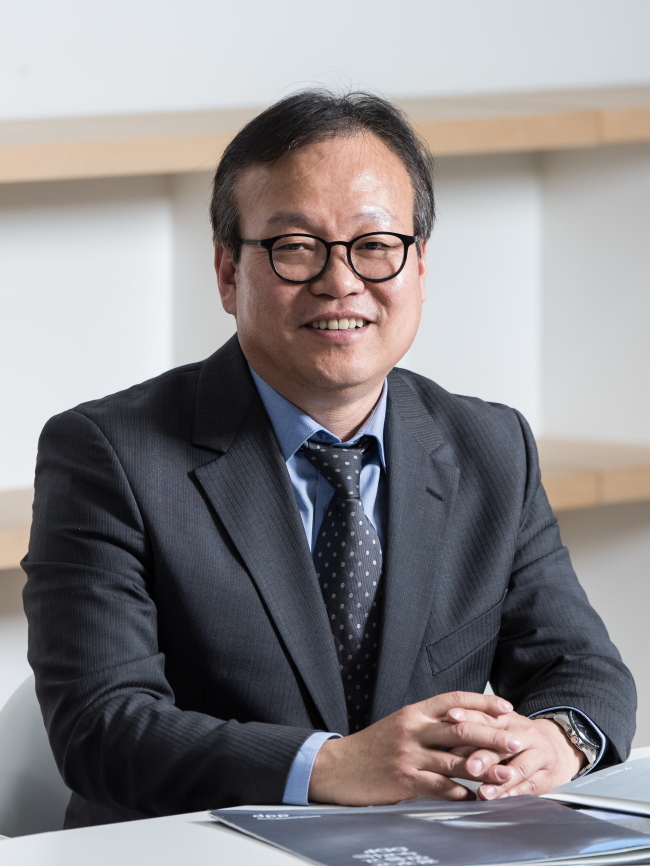“It looks like a giant spaceship,” is the phrase that Lee Keun, CEO of the Seoul Design Foundation, has heard the most since Dongdaemun Design Plaza was unveiled to the public in 2014.
Replacement of the 80-year-old sports stadium kicked off in 2007 as part of a city regeneration project. The site was reborn as a four-story complex, designed by Zaha Hadid, an award-winning architect who died in March.
The ultramodern design of the plaza -- with a total floor area of 87,000 square meters -- marked a significant transformation of the image and characteristics of the area around Dongdaemun, or Heunginjimun, one of the eight old gates of Seoul.
The DDP’s unique exterior has garnered international attention since it opened. Big fashion names such as Dior also showed interest. Held from June to August last year, Dior’s “Espirit Dior” exhibition attracted millions of visitors.
 |
Dongdaemun Design Plaza (Seoul Design Foundation) |
“I think the DDP’s unique exterior design appeals to global brands. We have been hosting Seoul Fashion Week since 2014 as well, which helped Seoul to be recognized as one of the stylish cities,” Lee told The Korea Herald. Lee’s foundation under Seoul City is responsible for overseeing various design projects of the capital as well as the operation of the DDP.
The DDP currently serves as a multipurpose venue for performances and house businesses, stores and other recreational spaces.
The renovation of the area was decided by the Dongdaemun district and Seoul City to replace the decades-old stadium that had lost its purpose and served as a temporary parking lot since 2003.
The decision thus was also controversial, with the neighboring marketplaces complaining that the plaza would be out of place and would hurt their businesses. Since the 1980s, Dongdaemun has been a landmark destination for locals and tourists for its wide range of wholesalers and retailers in the garment, textile and fashion industries.
“Vendors from shops across the street often said that it was better back in the day when sports games attracted swarms of people to the stadium. They regarded the DDP as an extremely fancy and luxurious building,” said Lee.
Lee, a former industrial designer and professor at Hongik University, began to head the foundation in April last year.
He received a master’s degree in vehicle design at the Royal College of Art in 1992 and worked as a vehicle design researcher at Daewoo Motor Company’s Design Center until 2001. He has been heading the Personal Mobility Research Center at Hongik University since 2013. He has also been heading the International Design School for Advanced Studies since 2012.
 |
Seoul Design Foundation CEO Lee Keun (Seoul Design Foundation) |
Lee said there was a need for the DDP to coexist with vendors in the area.
“We just began hosting night markets in May that visitors can enjoy, with over 40 food trucks and 80 design product booths,” Lee said.”
Last year alone, over 7 million visitors participated in the DDP’s variety of cultural programs, fairs and events.
The DDP was also selected by The New York Times as one of 52 must-visit tourist attractions in 2015.
“To be honest, I think urban renewals should be carefully done as pieces of the past can be lost in the newly built space. Redevelopment should be done with respect to history and residents,” Lee said.
Lee also noted that urban architects should preserve the history of the areas they work in, citing Bukchon Hanok Village in northern Seoul and Cheonggyecheon stream, a 10.9 km-long modern public recreation space in downtown Seoul.
In 2007, relics of the past were discovered during the construction of the DDP. Through a cultural properties’ investigation, a total of 5,200 relics are now preserved and showcased inside the DDP’s Dongdaemun History and Culture Park.
“The spatial advantages that history gives cannot be replaced by urban architecture, because constructing a building also means that an atmosphere around it will be built. It is important to see the role of the architect as someone that can plant a memorable experience in Seoul,” he said.
“The main idea will not be about what to build, but about what kind of atmosphere will be created with the coexistence of old and new architects.”
Although DDP stands for Dongdaemun Design Plaza, it can also mean “Dream, Design and Play,” according to Lee.
Lee has been dreaming of a place where art performances, exhibitions, shopping and dining can happen.
“In Paris, popular arts and science museums such as the Pompidou Center are always open to public. Open-door arts which encourage participation from the public is something that we are aiming for,” said Lee.
When asked about the Pompidou Center opening a branch in Seoul, Lee welcomed the idea and said that it would lead to synergized efforts in the arts industry.
“Do we see it as a threatening rival in Korea’s art scene? No, in fact I really welcome the opening (of Centre Pompidou Seoul) and I am excited to experience the global arts trend.”
Art is borderless, has no boundary or superiority, Lee said.
“When hallyu first gained big attention in Japan, it was not something (that happened) because our culture was superior to that of other countries.
“I would like to spread the idea that Korea is a country of developed arts and (one that is) ready for creative collaborations, with an open-minded public who enjoys collaborative efforts in the art scene here,” added Lee.
By Kim Da-sol (
ddd@heraldcorp.com)









![[Herald Interview] How Gopizza got big in India](http://res.heraldm.com/phpwas/restmb_idxmake.php?idx=644&simg=/content/image/2024/11/20/20241120050057_0.jpg)